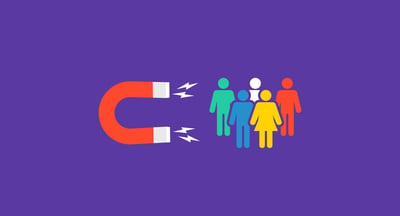February 23, 2023
 by Anastasia Chechkova / February 23, 2023
by Anastasia Chechkova / February 23, 2023

As if attracting and qualifying new prospects isn't hard enough, sales reps also need to put in the time and effort to close deals.
But to close sales and grow revenue, businesses must first build meaningful customer relationships. And they typically do that through sales calls.
Although phone calls are becoming less common in our day-to-day lives, they're still effective in a professional setting. This blog post will explain what sales calls are and how you can make the most out of them and close more deals.
Sales calling, or telesales, is a process of selling goods or services over the phone via a traditional landline, cellular network, or the internet. Sales calls are usually made by sales representatives (often referred to as sales reps) and can happen both at the top and middle of the sales funnel.
If a sales call happens at the top of the funnel, it’s usually more about introducing the company and its services to potential clients. If a call takes place somewhere in the middle of the sales funnel, it’s more geared toward building a connection with a client to move the sale or close the deal.
Besides their obvious goal of selling, sales calls can also help businesses identify clients' needs, establish a more personal connection, and explain how a particular service or product can meet clients’ requirements.
Sales calls can take place in-person or online, depending on your business model, and usually consist of several parts.
Different types of sales calls exist depending on why you’re calling a client and what you want to achieve. Each of them comes with its challenges and specifics.
For example, if you’re calling an existing client, you won’t need to introduce your company. On the contrary, your sales script structure will look completely different if you reach out to a lead who’s never heard about your business.
Knowing these differences can make your sales calls more effective and tailor them to different situations.
Cold calls are probably the first thing that comes to mind when you think about telesales. Cold calls are widespread and still popular in many industries. They’re usually unexpected and unsolicited, hence, their bad reputation.
Nevertheless, 85% of decision-makers respond to cold outreach from time to time. That’s why instead of giving up cold calls, many businesses try to find ways to improve their cold-calling strategy and make a good first impression on potential clients.
As you can guess from the name, warm calls are the opposite of cold calls. A sales rep calls someone they already have a connection with. Warm calls are typically aimed at existing customers or prospects who have already had some touchpoints with a company. These calls have a higher chance of success because they're often planned or arranged in advance.
The main goal of a follow-up call is to agree on the next step and move the sales deal or the project forward. Sometimes potential clients stop replying to emails or disappear from your radar completely. This doesn’t always indicate their loss of interest. Sometimes, they might be busy with urgent tasks or overwhelmed with their workload.
This is where a follow-up call is convenient. For example, if you notice that a warm lead doesn’t reply to your follow-up emails, you can call them to double-check if they’ve received your messages or need more details.
Besides cold and warm calls, hot calls also exist. Clients or leads usually initiate hot calls. For example, when they ask for a demo or want to learn more about your services. These calls are typically held with decision-makers, making them so effective.
In this situation, the prospect and the salesperson agree on the call in advance. The prospect is interested and probably knows about your products or services and their benefits. During hot calls, sales reps focus on identifying clients’ pain points and demoing how the solution can alleviate them.
If you’ve ever researched how effective sales calls are, you might have noticed that many resources mention conflicting information. On one side, calling is still popular among businesses of all sizes, but on the other side, cold calls are believed to be effective in around 2% of cases.
This looks confusing, right?
There’s an explanation for this. For example, research by RAIN Group reveals the following:
In other words, sales calls, even the cold ones, are an effective way to grab clients’ attention and win a deal. However, since there are different types of sales calls, not all are designed to close deals on the spot. Still, the calls at the top of the funnel can also indirectly help you increase the number of deals closed.
For example, sometimes, you need to get on the phone with a client to remind them about something or answer their questions. Such calls don't involve signing a contract, but these interactions contribute to the overall success of your sales process. After all, sales is a long game.
Sales reps often feel pressured to perform their best during sales calls. Although there’s no one-size-fits-all solution for a perfect sales call, a few dos and don’ts can help you perform better and move things in the right direction.
The best practices for making a sales call can be very obvious, such as recording a conversion or keeping it friendly and professional. You probably know most of these tips. We’ve compiled five not-so-obvious ways to keep your sales calls effective here.
As obvious as it may sound, sales isn’t something brand-new. This is probably one of the oldest professions in the world. And many resources exist on how you can sell more or grow your bottom line more quickly. If you’re struggling with sales calls, it might be a good idea to tap into the knowledge of others and adjust their examples to your situation.
If you’re new to sales calls, you can Google a few tips on improving your performance. After doing your research, you might notice that these tips are repetitive. Once you grasp the most common dos and don’ts, it’s time to look for real-life examples from sales practitioners or influencers.
Consider watching YouTube videos or listening to podcasts. The great thing about this type of content is that you can get a script and a glimpse into how these lines should be delivered.
Nevertheless, remember that no matter how good a script is, it’s still just a recommendation: someone shares their personal experience and lessons learned with you. That’s why during your research, make sure that you don’t only absorb knowledge but also adjust the experiences of others to your needs.
Even if you’re not a fan of sales calls, you can turn them into a pleasant experience by treating every sales call as an opportunity to improve your communication skills and get to know your clients better.
To make sales calls more effective, handle them as small assignments that are part of a bigger process. Try mapping out your whole sales process to have the full picture in front of you. This will help you visualize how sales calls contribute to your overall success and what role they play in closing deals.
Another essential thing to consider has realistic and tangible sales key performance indicators (KPIs). If your goal is to call 30 prospects every day, you probably won’t be satisfied with your results by the end of the quarter. The number of sales calls made won’t directly impact your revenue and is usually referred to as a vanity metric.
Instead, ensure that every call you make is backed up by thorough research to focus only on the most relevant leads and clients. Also, since every call is a small assignment, ensure that you always have a goal for your calls (the desired outcome) and the next step in mind. In other words, don’t treat sales calls in isolation from your other processes.
The term ‘sales call’ might be a bit misleading. Not every sales call should necessarily lead to a sale straight away. Sales calls are one of the many steps in nurturing leads and bringing them closer to a sale.
That’s why you can use them to build relationships with clients throughout the sales process.
Here are a few sales call dos and don’ts:
With sales calls, you can’t be sure of the outcome. Even if you do thorough research on finding leads, sometimes, during the conversion, the person on the other end of the line isn’t the best audience for your offerings.
It’s important to recognize this early on and choose your battles wisely. While many sales reps try to negotiate and handle objections, sometimes it’s fine to take a step back and reflect: Does our solution really help this person? Are they the right target audience?
If the answer is “no,” don’t be afraid to disqualify them from the beginning. This will save you time and let you focus on other opportunities where you have a higher chance of closing a deal.
When you disqualify a lead, it isn’t always due to bad research. Sometimes things change. If you qualified a prospect yesterday, you might reconsider your decision next week. For example, they might get new management or start working with your competitor instead. The economic situation in the country can also drastically change in a week.
In other words, you don’t have control over many factors. It’s fine to take a moment to reflect on whether a particular lead is the right person to have on your sales call.
Sales calls are just a small part of your sales process. But they’re still important. You can get vital information from your leads and clients during sales calls. That’s why you need to keep a record of all your client interactions in a CRM, including meeting notes.
These notes will be handy later on for establishing a connection with a client or personalizing your communication. Did the client mention they struggle with a specific issue? Send them a follow-up email with helpful resources that they can use to resolve the issue.
As surprising as it might sound, your CRM shouldn’t always be the only source of information you get about clients. Before making a sales call, check out their LinkedIn profile or company page on social media if you’re doing B2B sales. Some things can change: they might have a new manager or some important announcement. Being aware of these changes gives you a slight advantage.
For an extra layer of insight, using inbound call tracking software ensures every lead is accounted for, helping you optimize follow-ups and close more deals.
Sales calls can be very effective but don’t view them as the only tool for closing deals. They’re part of your sales process and should seamlessly complement other steps.
Here are a few things to keep in mind to close more deals with sales calls:
Take control of your sales success and improve your lead generation efforts! Learn more about lead nurturing, uncover hidden opportunities, and build lasting relationships with your prospects.
Anastasia Chechkova is a Growth Analyst at OnePageCRM, a simple sales CRM for small businesses. She has degrees in corporate finance and linguistics and a passion for data management.
Unfortunately, the business world is full of skeptics.
 by Mary Clare Novak
by Mary Clare Novak
Is acquiring new customers important to your business?
 by Izabelle Hundrev
by Izabelle Hundrev
Maintaining a healthy sales pipeline hinges on effective sales prospecting
 by Mary Clare Novak
by Mary Clare Novak
Unfortunately, the business world is full of skeptics.
 by Mary Clare Novak
by Mary Clare Novak
Is acquiring new customers important to your business?
 by Izabelle Hundrev
by Izabelle Hundrev


